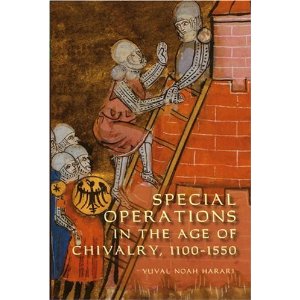
Yuval Noah Harari
Special Operations in the Age of Chivalry, 1100-1550
Warfare in History, 24. Woodbridge: The Boydell Press, 2009. 248pp. $24.95. ISBN 978-1843832928.
The terms “Special Operations” invoke images of highly trained professional soldiers, evolving in shadows and performing missions sometimes best kept secret. Members of modern Special Forces live and maneuver in a grey world and although their deeds and feats are sometimes publicized, the identity of each man of these elite groups is fiercely protected. Such practices do not quite fit with the idea one generally entertains of medieval warfare and of a time when examples of honorable conduct, great warriors, and great deeds were used as sources for the composition of entertaining and didactic pieces.
Yuval Noah Harari, who teaches at Hebrew University of Jerusalem, finds himself surrounded by a military environment based on unconventional warfare (Hamas, Hezbollah, Mossad) that provided much inspiration and fuel for the composition of his work. Harari aims at filling gaps in both academic and popular publication fields on a subject that been commented upon by historians but that has also not yet produced much book-length research.
Special Operations in the Age of Chivalry is divided into seven parts, six of which exclusively focus on particular occurrences of medieval special operations: Antioch, 1098; Khartpert 1123; Tyre , 1192; Calais, 1350; the rise of Valois Burgundy, 1407-83; and Auriol, 1536. Most of what could be considered to be the academic or theoretical content is found in the first part (which comprises about one third of the whole work ) which offers readers a general analytical overview of the subject. In this analysis, Harari tackles some of the hard questions raised by such a subject and attempts to define the nature of special operations an “age of chivalry.” It is in this part of the work that some of its most serious challenges can be found. Harari does not write that deception, treachery, bribery, or assassination as means of military operations were against chivalric practices or codes of conduct per se. Instead, he writes that such methods, although common, were not the normal modus operandi. This made such operations “special”. Moreover, the author defines a “special operation” as “a combat operation that is limited to a small area, takes a relatively short span of time, and is conducted by a small force, yet is capable of achieving significant strategic or political results disproportional to the resources invested in it.” (1)
Harari’s definition fits within the accepted modern understanding of what special operations are, but one can wonder if such a definition can pass the test posed by medieval (or “chivalric”) military practices. If one were to accept Harari’s definition, then one would also have to accept that large set battles were the norm of medieval chivalric warfare, and that smaller size engagements were de facto exceptions to the norm and therefore “special.” But set-piece engagements between armies were in fact quite rare in the time period studied by Harari, and small raids or operations were more than likely to take place. Harari can draw from so many examples of special operations (the methodology of selection of these examples is unclear) that one can wonder if all small raids could in fact, according to the author’s own definition, qualify as “special.” Thus, Harari’s premise for his work relies on a definition of special operations that will leave the reader with many additional questions and concerns (while leaving aside the use of the terms “age of chivalry” altogether.) His premise, though, also opens the door for exciting and inquisitive forays into this under-studied aspect of medieval warfare.
The second part of the book, also its largest, is composed of the six case studies that describe and explain in detail instances of special operations in narrative form. These six chapters are much more vivid than the first part and clearly attempt to address a broader base of general readers: historians and enthusiasts, rather than academic medievalists. But as vivid and interestingly written as they are, the accuracy of these 6 case studies is hard to assess. The author himself admits that a mix of time delay between the actual events and the composition of the narration and less-than-plentiful sources proved to be a challenge when trying to describe events that unfolded a long time ago. Yet, Harari delivers well research, well written, informative and truly enjoyable narratives that will not only catch one’s attention but will also stimulate the imagination. Harari’s narratives of the 1192 assassination of King Conrad of Jerusalem, which was done by the Nizaris (arguably one of the few medieval forces that could be considered an equivalent to modern “special forces,”) and of the 1536 destruction of the Imperial mill at Auriol by the French do make a strong argument for the existence of medieval enterprises performed by small groups of highly trained men that were planned around military and political goals. The manners in which these two medieval enterprises were conducted remind us of the planning and execution of modern special operations, and therefore bring to light the value and originality of Harari’s work.
Yuval Noah Harari’s goal was to document and bring attention to an aspect of medieval warfare that had not, until the publication of his work, been the exclusive focus of book length research. Although some questions beg to be revisited or explored in greater depths (the contrast between special operations based on deception and trickery and knightly/chivalric codes of conduct based on honor, or short term and long term consequences of using special operations,) Special Operations in the Age of Chivalry, 1100-1550 unequivocally does illustrate the importance of special operations and of small scale initiatives in medieval warfare. Harari’s prose and research will appeal to both academics and enthusiasts of military history. Special Operations in the Age of Chivalry, 1100-1550 is a great contribution to the field and should inspire many more studies.
 Matthieu Chan Tsin
Matthieu Chan Tsin